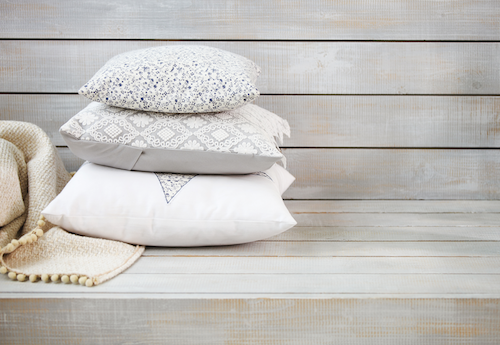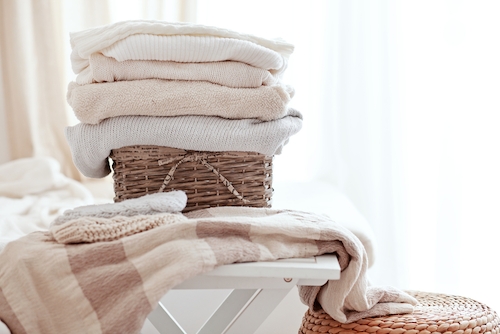Who doesn’t love a cozy Hygge home? But with all of the different fabrics and materials in your luxe nest, it might become overwhelming to maintain a Hygge interior. If you’re looking to live a more sustainable lifestyle in your plush Hygge home, start by opting for easy, eco-friendly fabric care.
Make simple choices in your everyday living such as switching to fragrance free detergents and soaps and upgrading to sustainable fabric and furniture for your home. Here are 5 simple ways to maintain an eco-friendly Hygge home.

1| Flip Rugs and Cushions
One of the quickest and simplest ways to extend the life of your rugs and cushions is to flip or rotate them. Regularly rotate rugs at least once a year for even wear. If you have any area rugs in the bedroom or living room, be sure to flip them or switch them out every once in a while when you update your home decor.
Rugs in high traffic areas like the kitchen, bathroom, and hallways should be flipped or rotated every few months. The same rule applies to cushions. If your rug or cushion has two different sides with different colors or patterns on each side, take advantage of the various style options you have with each piece.
Not only do you have more options for your home decor, you’re also saving money and the environment by not having to consume additional items or materials.

2| Sustainable Washing & Drying
Avoid anything with harsh detergents. Not only are harsh chemicals and strong detergents harmful to the environment, they can also damage your fabrics. When it comes to home textiles such as rugs and throws, it is best to wash when needed or not as frequently as you would wash the laundry and bed sheets.
Use eco-friendly detergents and natural cleaning solutions to preserve the life of your fabrics and textiles.
Most fabrics can be washed separately in cold water to reduce color fade, dye stains, and color bleeding. Avoid bleach, brighteners, and fabric softeners if not needed. Try to hand wash and hang dry or lay flat to dry as often as possible, since handwashing and hang drying are more gentle for fabrics. Never overdry textiles in the dryer.
If you must use a dryer, use the low heat or no heat dryer setting and partially dry halfway so you can take them out of the dryer and air dry later. Just watch out for dry clean only fabrics and avoid direct sunlight if you are line drying outside.

3| Bamboo Pillow Cases & Duvet Covers
Pillow cases and duvet covers protect your pillows and quilts so they can last longer. There are hot and cool fabrics for different seasons and temperatures that you want to consider for your home, including bamboo bed sheets.
As a fabric, bamboo is comfortable and stain resistant which also means that you won’t have to use any harsh chemicals such as stain removers, bleach, or fabric softeners. Bamboo is a plant that does not require a large amount of water to grow compared to other plants that can be sourced to make fabric, which makes bamboo one of the most sustainable and eco-friendly fabric choices in the market. Bamboo is also stronger than cotton, so it is more durable and lasts longer than cotton.
Our body temperature naturally drops a little to help us prepare for rest. This correlates with our circadian rhythm. When the sun rises, our body warms up so we can wake up and get ready for the day. In the evening when the sun sets, we naturally cool down, unwind, and relax. Bamboo is cooler than cotton and can therefore improve the quality of sleep.
It absorbs moisture and sweat and is naturally hypoallergenic and antibacterial. By upgrading to bamboo bed sheets, you can reduce dust mites and allergens in your home. Bamboo is also UV resistant so the color and fabric material will last longer than other materials, making it a better choice for the environment (and your wallet.)

4| Fluff Your Pillows
Another simple and quick habit to incorporate into your eco-living routine is fluffing pillows and shaking blankets, rugs, and throws regularly. It’s such a great feeling to have fresh fluffy pillows! Get rid of dust and preserve your pillows and pillowcases by fluffing them. When you sleep, moisture gets trapped in your pillows and cause them to lose shape.
Dry out any moisture from your pillows by letting your pillows sit in the sun. Leaving your pillows in the sun for a few hours will help evaporate any moisture from the pillow. Not only will your pillows be fluffy again in no time, sun exposure is also a natural way to disinfect pillows.
Don’t forget to rotate your pillows regularly to maintain its shape and to wash your pillows occasionally until they need to be replaced.

5| Hypoallergenic Fabric
If you want a green home and a healthier lifestyle, invest in quality materials such as hypoallergenic fabric. Some good fabric choices are organic bamboo, organic cotton, linen, and hemp. Hypoallergenic bed sheets have tighter fabric weave to prevent dust mites.
Hypoallergenic fabrics are also good for your skin because they are made without harmful chemicals that are known to cause allergies. Hypoallergenic fabrics are much easier to wash than synthetic fabrics. Lastly, if you’re a pet owner, natural fabrics and hypoallergenic fabrics don’t attract pet hair as much, which significantly reduces allergens in the home.
Small changes in your daily life can make a big difference for the environment when it comes to sustainable living and having an eco-friendly home. Let us know which of these healthy habits fit with your new eco-friendly lifestyle.
About the author: Lucy Parker is the Resident Design Consultant at HomeDecorAZ.com. When she’s not busy helping clients with interior design projects, Lucy writes blog posts related to home décor. She’s also a foodie who loves traveling and enjoys movies (except horror).